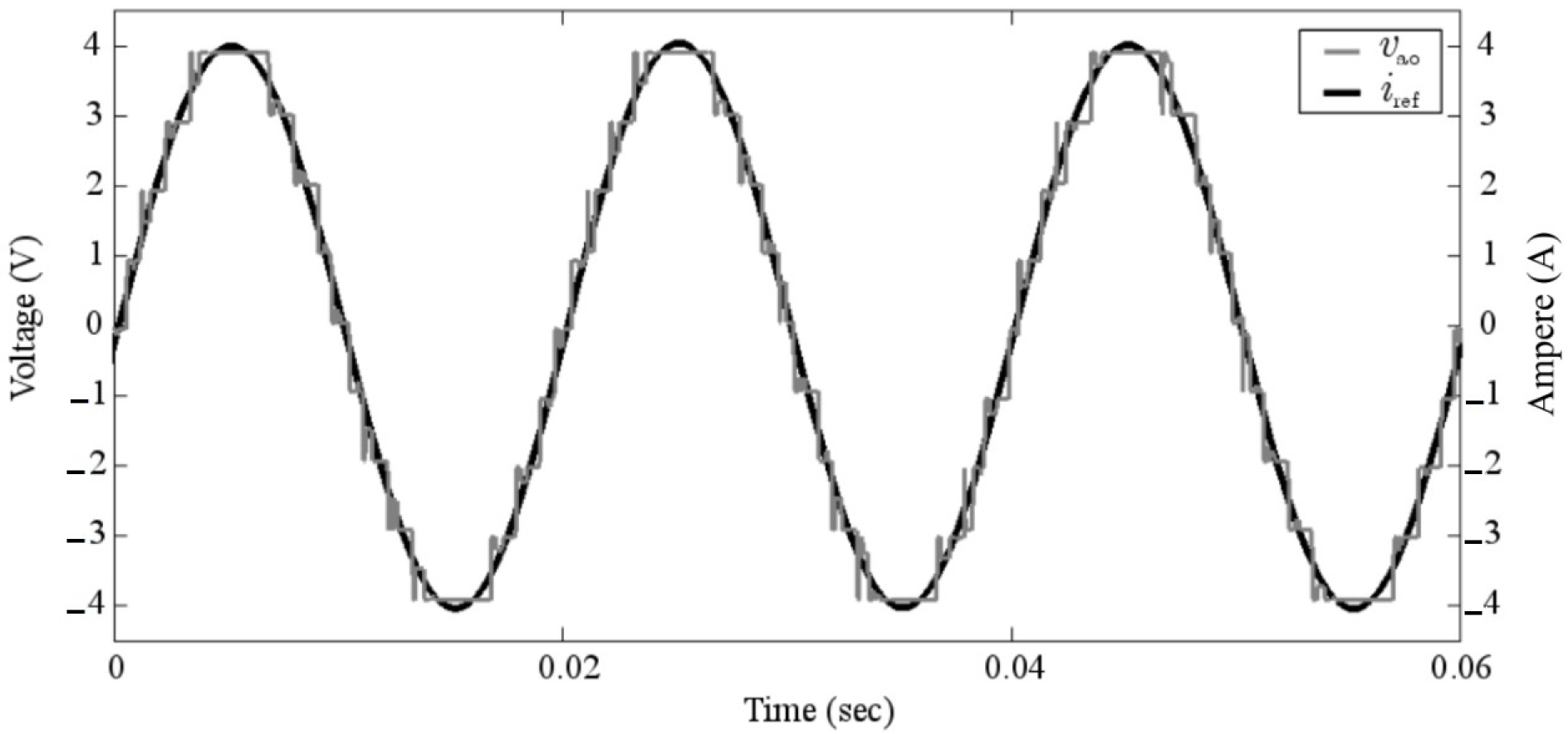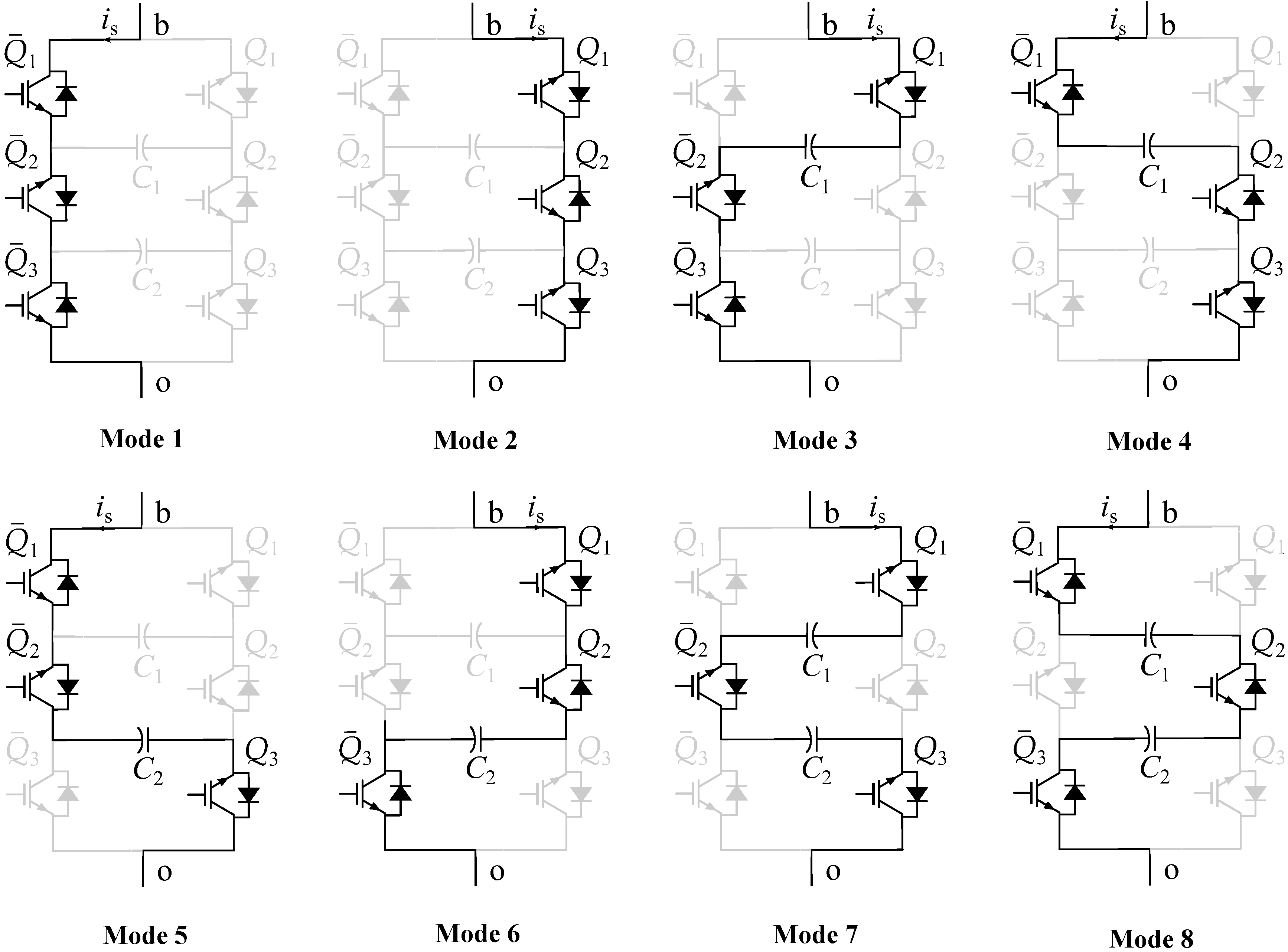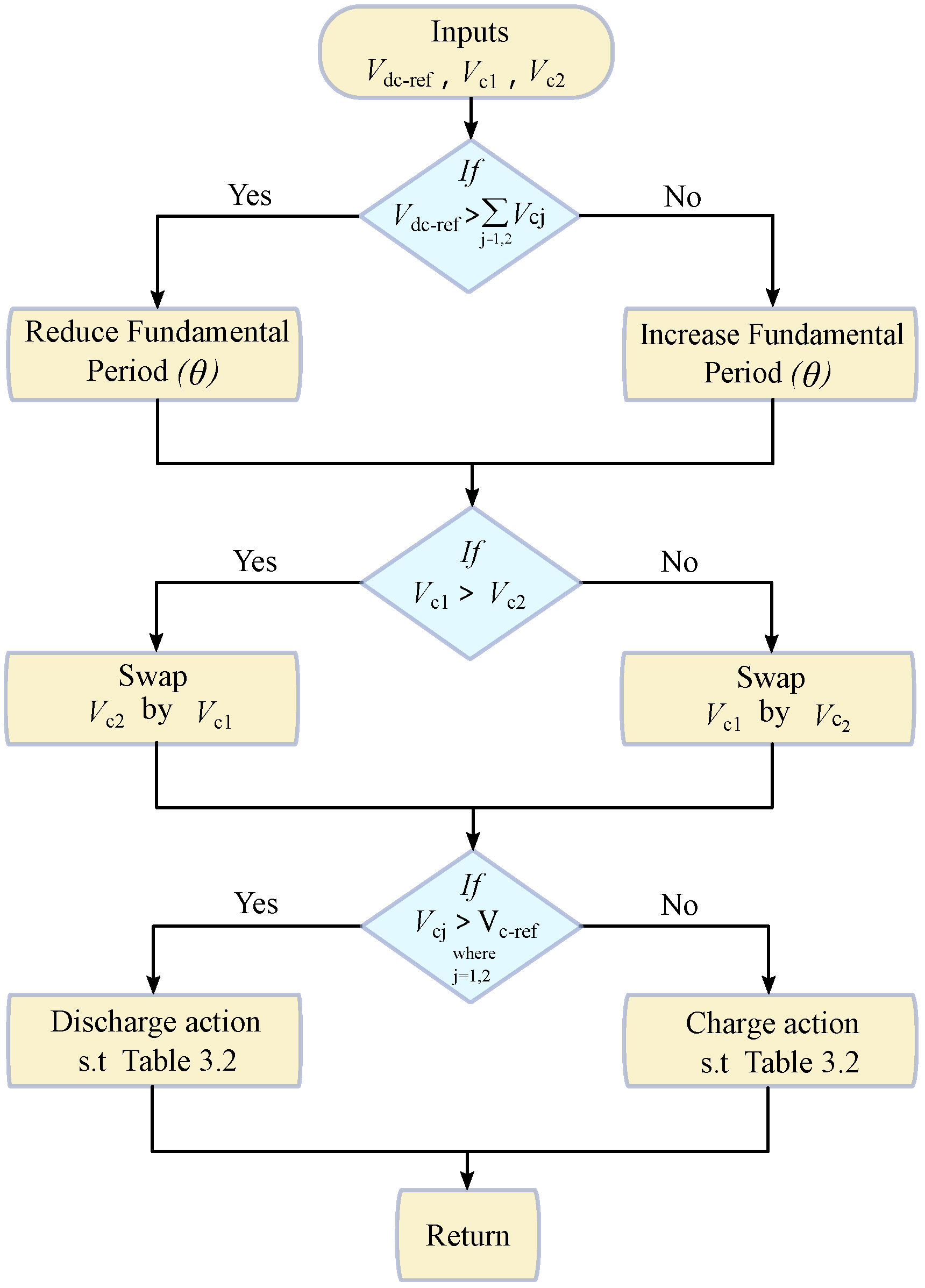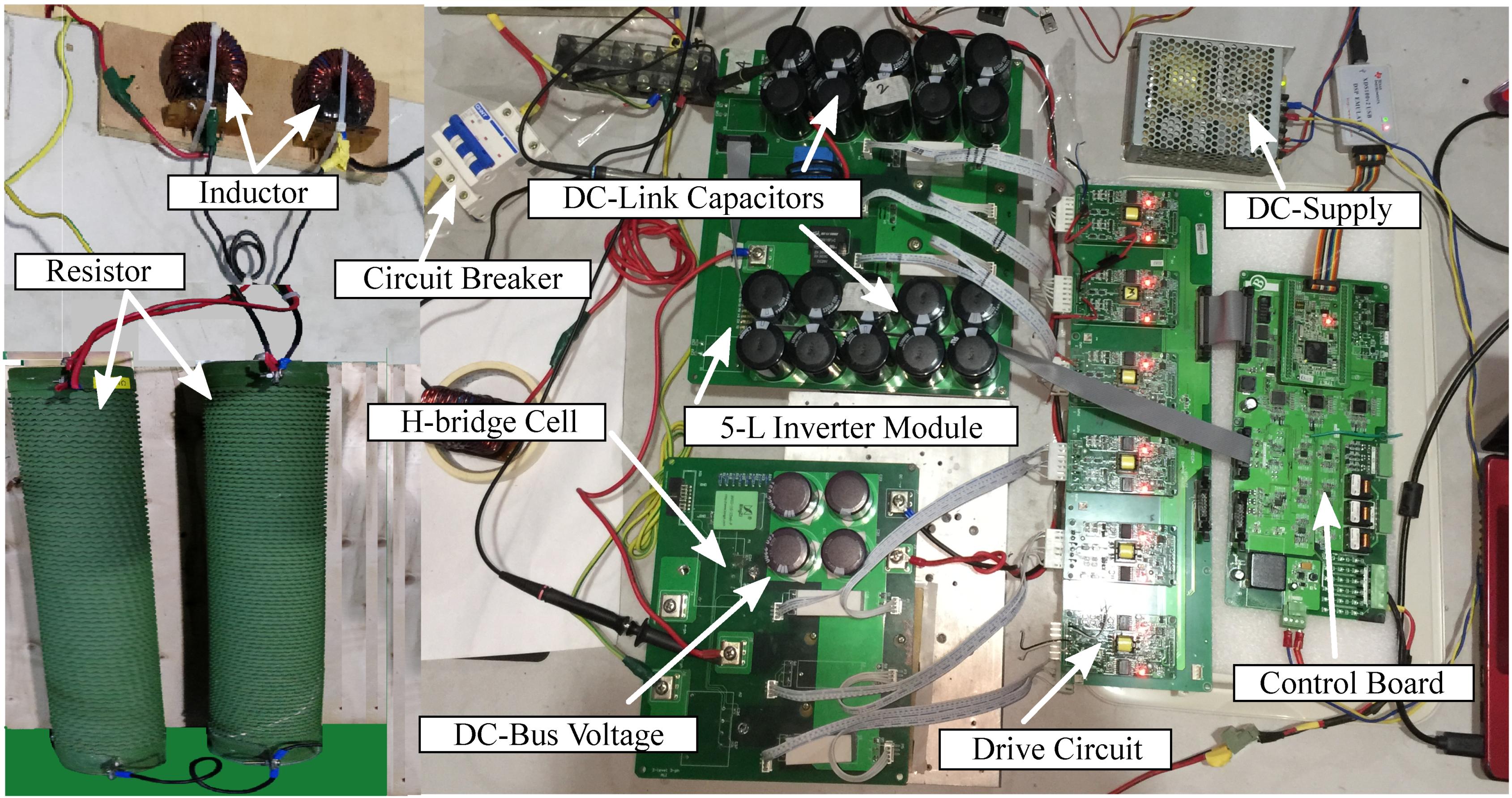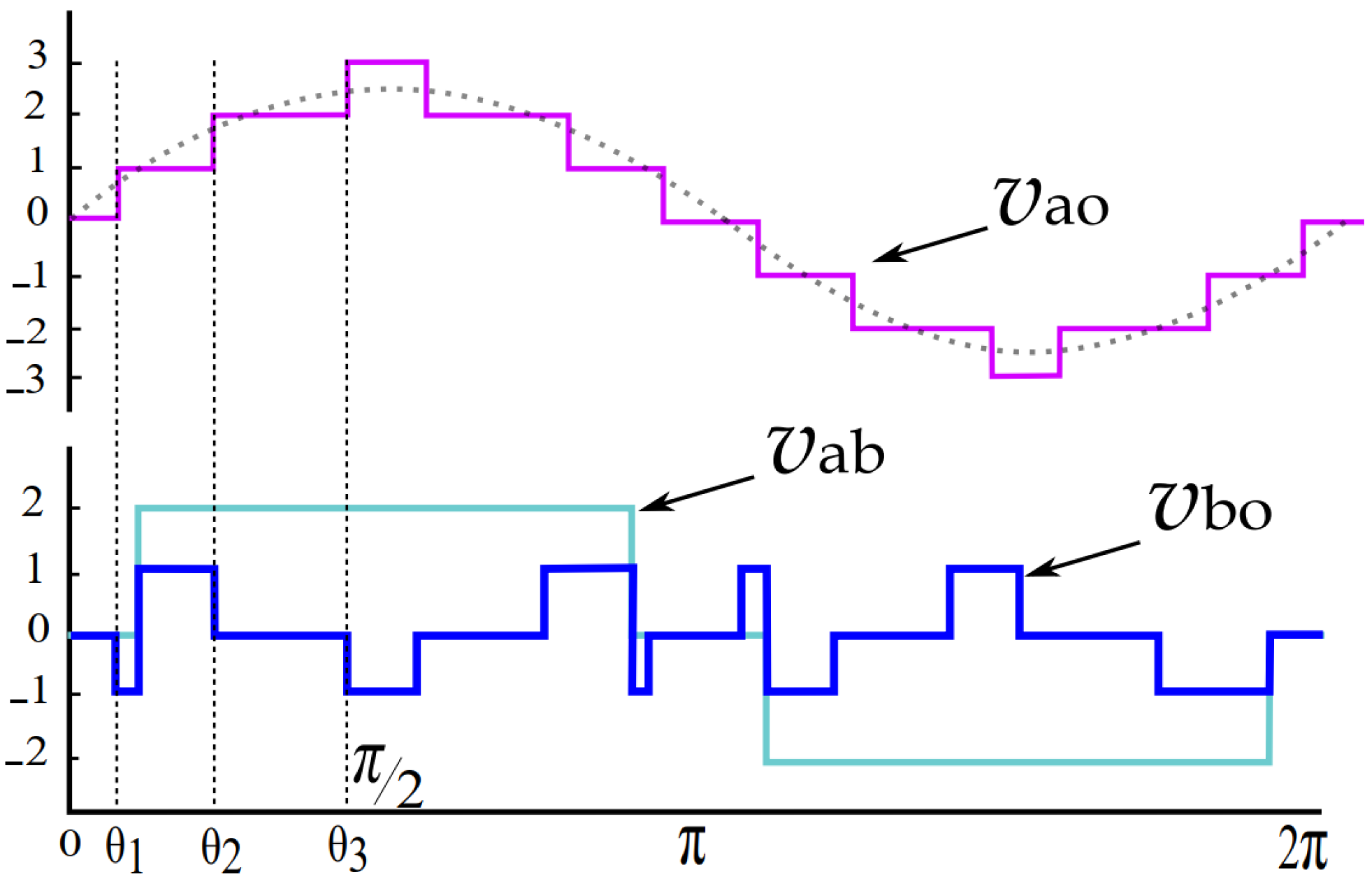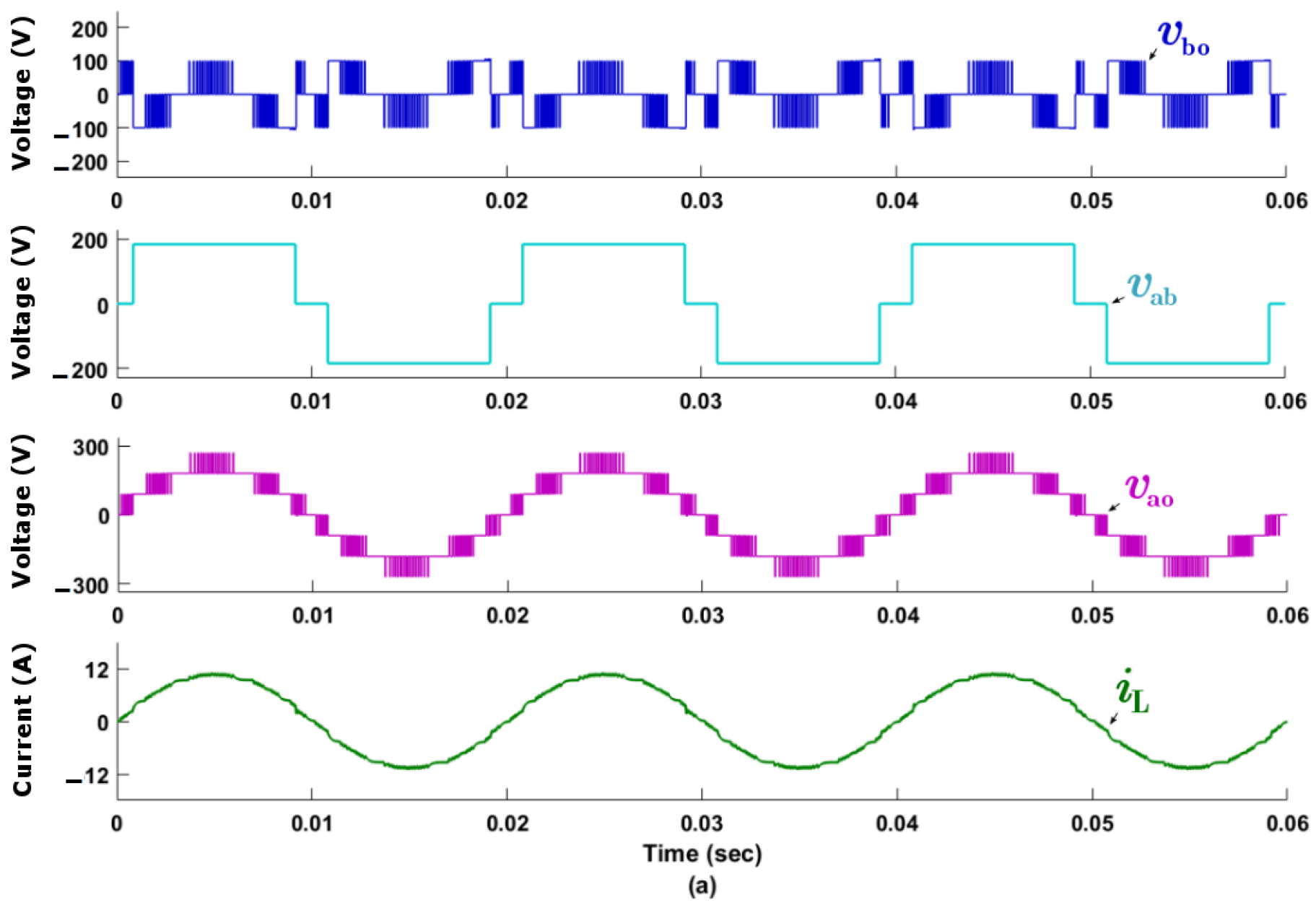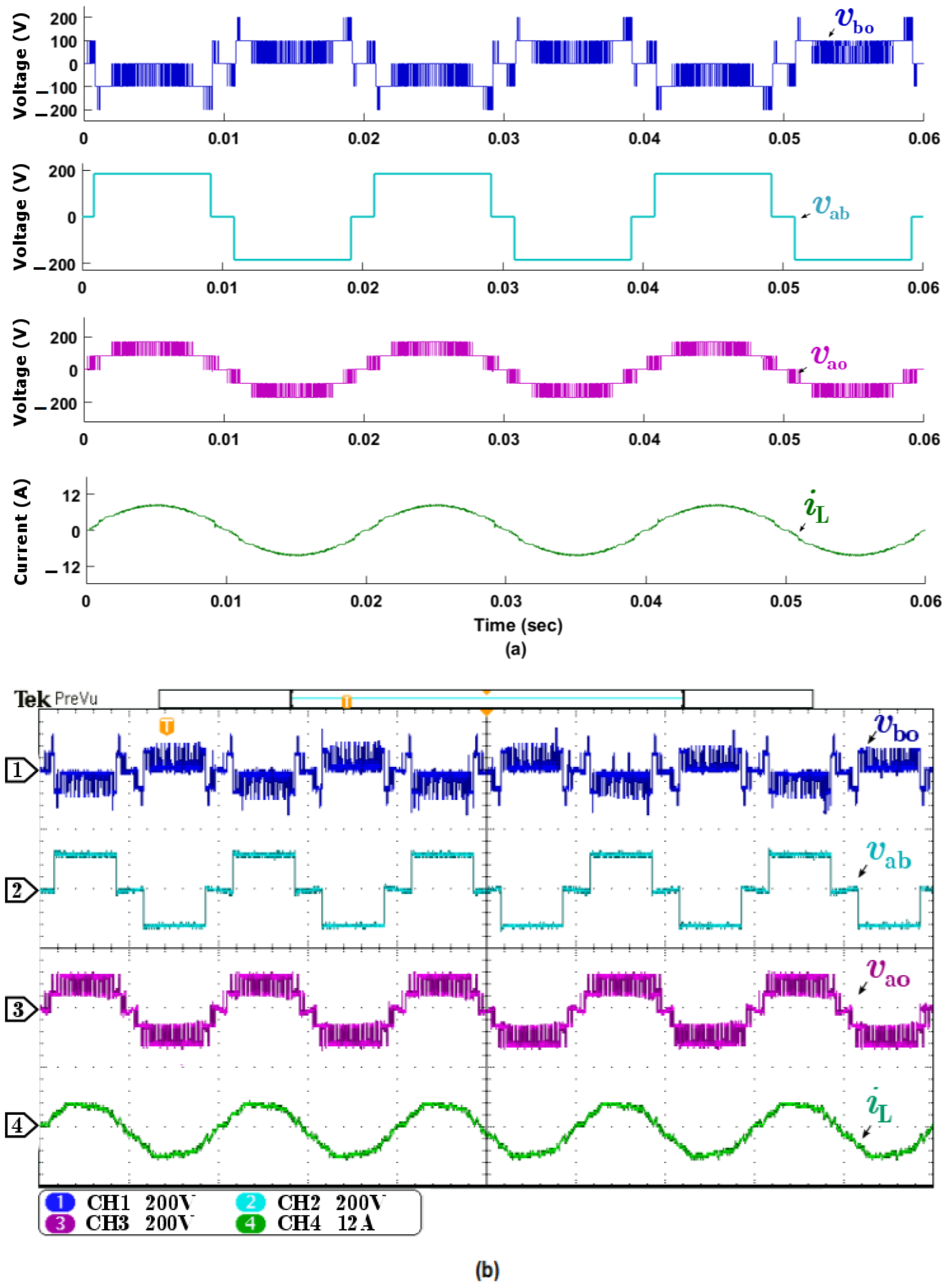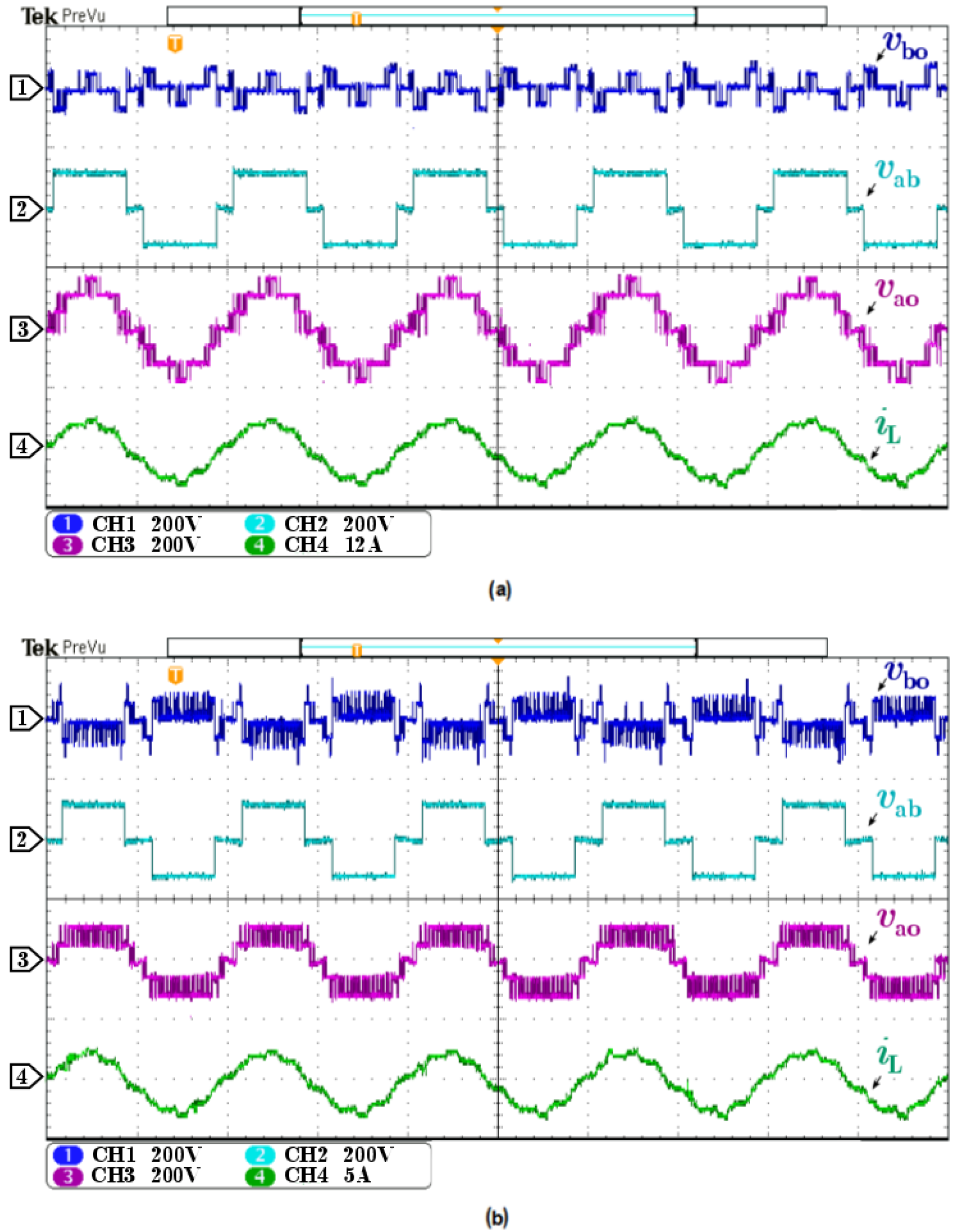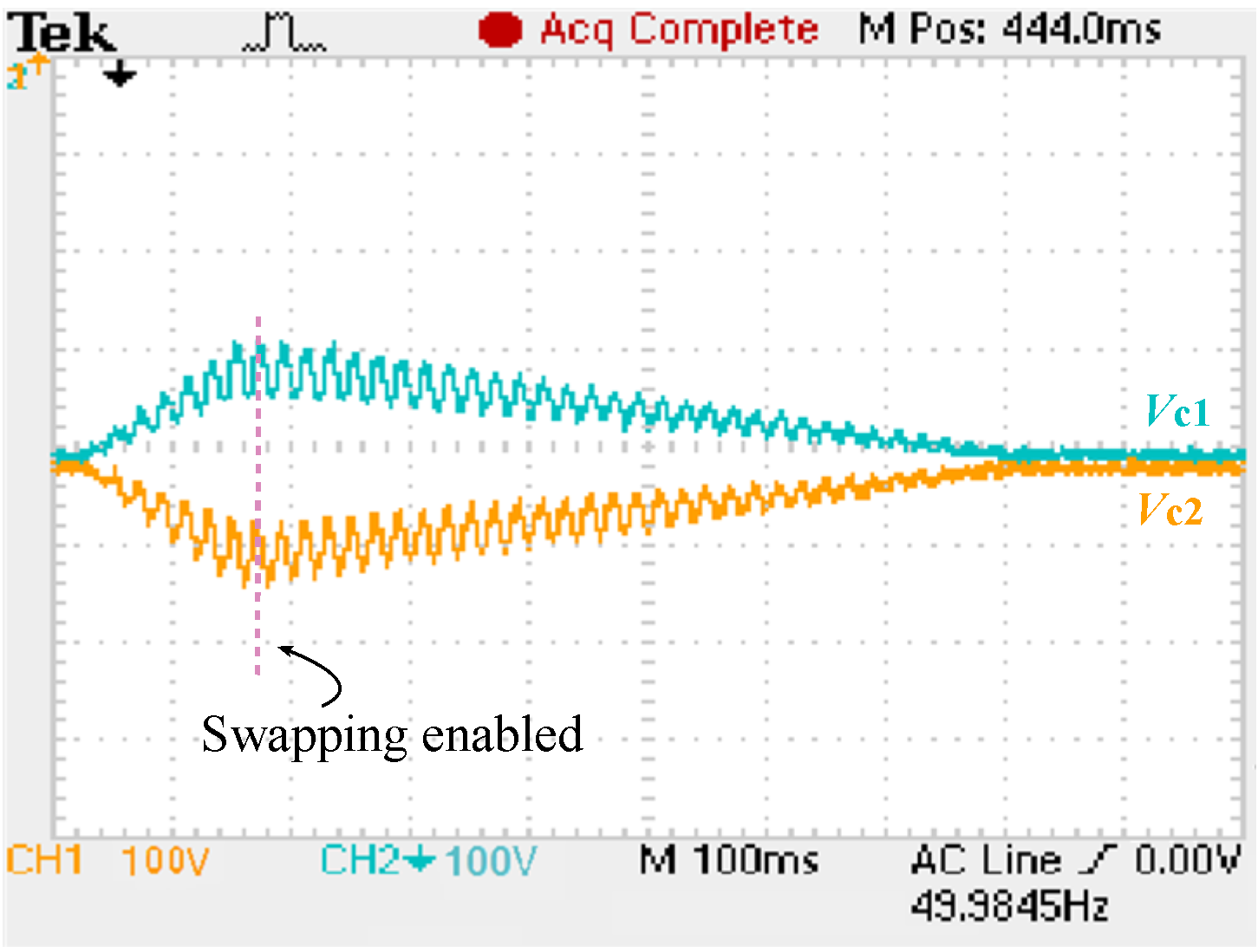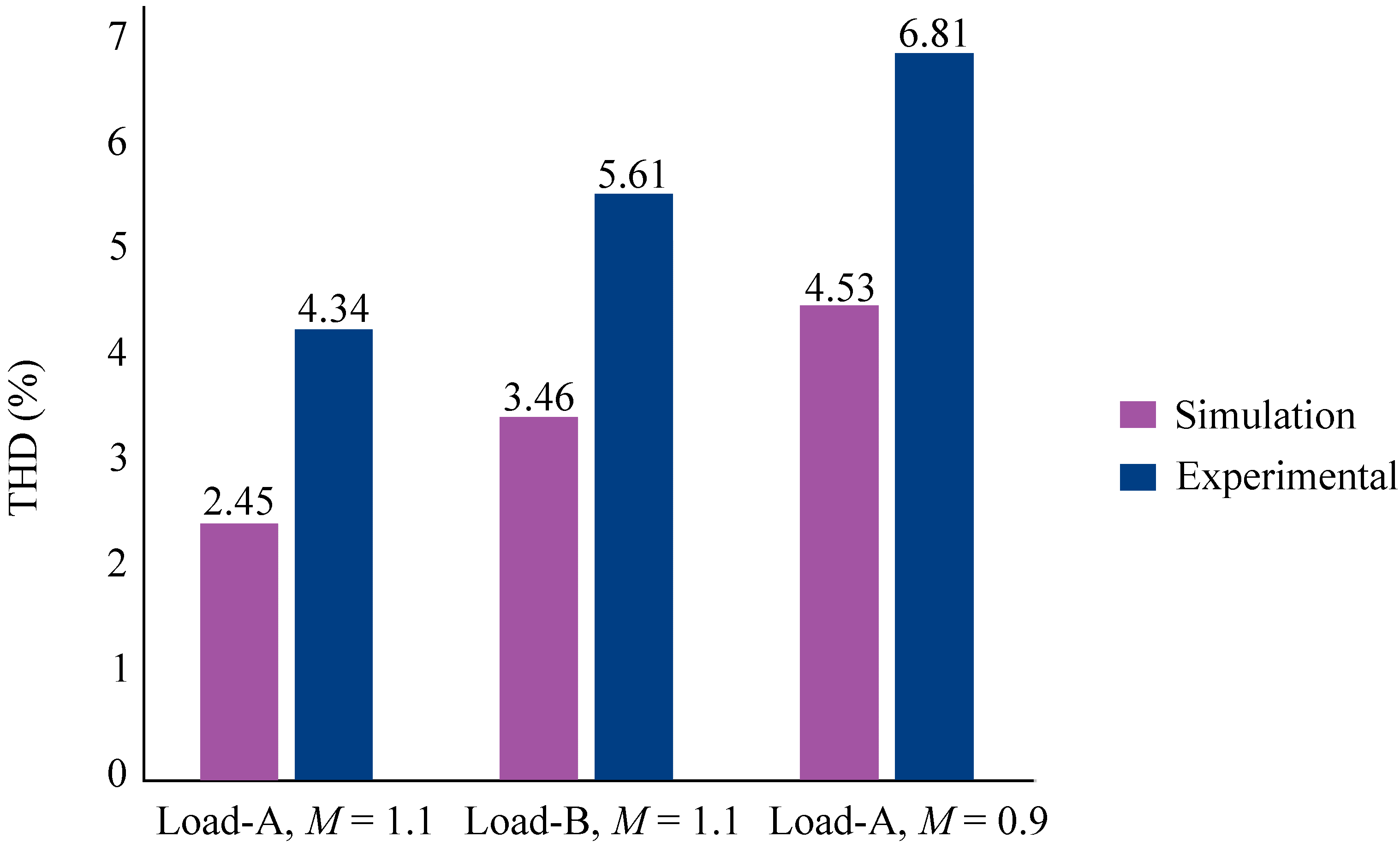1. Introduction
Over recent decades, multilevel converters (MLCs) have found popular in high-power applications. The reasons for their widespread acceptance are the capability to share the high-voltage stresses among the devices, low conduction and switching losses, and improved power quality with minimum harmonic distortion [
1,
2]. An attempt to enhance the power quality to IEEE standards, i.e., 5% current total harmonic distortion (THD), necessitates the generation of higher output voltage levels of the converter. However, the increase in output voltage level requires more components and floating capacitors, which results in increased cost and size of the converter system. Hybrid converter topologies as a combination of the conventional converters have achieved great attention from researchers [
3,
4,
5] due to their minimum requirement of components count. The hybrid converter is the cascade arrangement of dissimilar converters, which reduces the necessity of component requirements for the same output voltage levels.
Maintaining the power quality of the hybrid multilevel inverters (HMLIs) at acceptable standards (IEEE-519) is a challenge. Many advanced control methods have been developed in recent decades. The selective harmonic elimination pulse width modulation (SHE-PWM) [
6] is a common control method used in the HMLIs. The SHE-PWM offers good switching losses control, but its modulation raises the angle calculation complexity. More advanced control techniques are applied to hybrid converters, namely the sinusoidal PWM (SPWM) [
7,
8] and the model predictive control (MPC) [
9]. The MPC has been a promising control method for nearly three decades in industry and academia due to its numerous advantages for MLCs [
10]. This control technique is easily realized with less tuning complexity and can also include nonlinear systems and constraints easily. Moreover, the MPC directly achieves its objectives without angular calculation and reference voltage approximation methods, which reduces its implementation complexity in power electronic systems [
11]. Finite set model predictive control (FS-MPC) has been achieved popularity in power electronic systems due to its simple and flexible implementation [
9]. The discrete nature of FS-MPC allows its direct implementation and eliminates the PWM need. The FS-MPC is discussed widely in the literature for controlling DC-DC and AC-DC converters [
12,
13,
14,
15], multilevel converters such as packed U-cell (PUC) [
9], and flying capacitor-based ANPC hybrid converters in [
16]. The FS-MPC comprises finite control actions, among which the optimal control action is attained by solving optimization problem [
11]. Moreover, nonlinear control schemes, such as sliding mode control (SML) is used to control the switches of the multilevel converter and reduce the THD levels [
17,
18,
19,
20]. It is a robust and dynamic scheme that offers better performance, but much more complex and harder to designed and built.
In this paper, a circuit configuration of the proposed hybrid multilevel inverter (HMLI) based on the series arrangement of a cascaded converter module in series with an H-bridge converter is analyzed. Controllers have been employed based on a simplified model of the HMLI, which comprise of voltage and current controller. Based on the controller design, the work is split into two parts. As a first control method for newly devised topology, initially, the FS-MPC as a control technique is implemented on the HMLI, and theoretical analysis is carried out in MATLAB/Simulink environment. Using the FS-MPC method, the proposed converter generates a nine-level output voltage with reduced current distortion. Later, in the real-time implementation of the HMLI topology, a hybrid control scheme, a variant of the FS-MPC method, has been proposed. The proposed method is computationally efficient and therefore has been employed to the HMLI topology to operate the converter modules switches according to their voltage stresses. In the hybrid control strategy, the H-bridge converter operates at fundamental switching frequency whereas the cascaded converter module is controlled by FS-MPC which optimally predicts the next level, and the decision is applied through the pulse width modulation (PWM) method. The inverter topology and stability of the proposed control method have been validated through simulation and experimental results. A comparative analysis of the proposed inverter with existing topologies such as NPC [
21,
22], HNPC with H-bridge [
23,
24], HNPC with cascaded module [
25,
26], and PWM voltage source inverter [
27] is conducted to illustrate the advantages of the proposed work.
The outline of this paper is as follows. The circuit configuration and operation of the newly devised topology are explained in
Section 2. The FS-MPC as a control technique is implemented on the HMLI and theoretical analysis is carried out in MATLAB/Simulink environment in
Section 3. Later, in the real-time implementation of the HMLI topology, a hybrid control scheme, a variant of the FS-MPC method, has been discussed in
Section 4. Simulation and experimental results are shown and discussed in
Section 5, and a comparative analysis with the relevant topologies are also added in this section. Finally,
Section 6 concludes this paper.
4. Real-Time Inverter Implementation
The efficiency of the HMLI topology can be improved by reducing the switching loss. Therefore, the HMLI switches are categorized in terms of their voltage stress. In the HMLI topology, the high-voltage H-bridge converter provides fundamental component support; therefore, a fundamental switching frequency (50 Hz) is selected to minimize the switching loss. The low switching frequency will cause high harmonics, which is filtered through a series active filter (cascaded converter module). With this modulation strategy, the HMLI generates a seven-level output voltage.
The HMLI topology is based on a series arrangement of a five-level cascaded converter module with the three-level H-bridge converter to form a seven-level converter presented in
Figure 3. The five-level cascaded converter module circuit consists of two DC-link capacitors
and
, which are initially charged at
=
=
, and three pairs of alternately connected active switches (
,
,
). The H-bridge converter is comprised of four active switches (
–
) (two half bridges), which are connected in parallel with a single DC-bus voltage 2
. In this topology, the fundamental component is generated by the H-bridge converter with the output voltage levels of ±2
and 0. At the same time, the cascaded converter module (CCM) as a series active filter will produce five-level output voltage, namely ±2
, ±
, and 0. The combined operation of the HMLI generates a seven-level output voltage. In the HMLI circuit arrangement, the active switches of an H-bridge converter are handling high-voltage stress i.e., double then DC-link capacitors voltage of the CCM.
In the HMLI topology, the cascaded converter module is a vital part of circuit topology. It guarantees the seven-level output voltage of the HMLI with minimum harmonic distortion. The five-level output voltage of the cascaded converter module is ensured by the eight distinct switching modes depicted in
Figure 4 when the DC-link capacitor voltage is balanced to its reference value. The cascaded converter module has redundancy for output voltage level, namely ±
and zero levels, which ensures controllability of the capacitor; however, the ±2
has a unique state. The change in the ±2
is only determined by the direction of the current. As the cascaded converter gives harmonic component support to the HMLI, the DC-link capacitor charge is affected when the power is dissipated across the semiconductor devices during switching to attain the desired output voltage levels. Moreover, the DC-link capacitor voltage also deviates from its reference value when the output terminals are connected through any single capacitor. This happens when the output voltage level ±
is achieved; these switching states affect the DC-link capacitor voltage by either charging or discharging it, depending on the converter’s current direction as given in
Table 2.
4.1. Hybrid Modulation Strategy
A hybrid modulation strategy is employed to HMLI topology to overcome the high-frequency switching limitation of the MPC control method, as discussed. In this strategy, the converter modules which are under higher voltage stress are operated at the low switching frequency, and switches under low-voltage stress are operated with high switching frequency.
Figure 3 shows the seven-level HMLI topology connected to the RL load. The switches in the H-bridge converter are under higher voltage stress; therefore, they are modulated with a switching frequency of 50 Hz. The low switching frequency will help in reducing the switching loss of the H-bridge converter, but it will produce high harmonics. The cascaded converter module is introduced in series connection, which will filter out the high harmonics and enhanced the output voltage levels of the converter. The cascaded converter module switches are under low-voltage stress, while converter operation switching frequency of 1.6 kHz is observed.
The cascaded converter module is controlled by model predictive control (MPC), which optimally predicts the next level, and the decision is injected through the pulse width modulation (PWM) technique. The Fourier series expansion of the output voltage of a seven-level converter topology can be expressed as
where
n denotes the harmonic order.
is the firing angle of the fundamental converter, which can be expressed as follows:
4.1.1. Prediction Model
The dynamic model of a five-level cascaded converter module (CCM) shown in
Figure 5 can be equated as follows
where
R and
L denote the load resistor and inductor, respectively, whereas
and
are the switching functions of the converter module, which can be computed as follows:
For a given switch-direction, the DC-link capacitors voltage change is the function of converter current direction (
) which are expressed as
In the finite set model predictive control (FS-MPC) switching mode for each converter level is a direct control action from MPC, and the decision is then injected through PWM. In this case, the response time of MPC control action is dependent on the sampling time of .
As the cascaded module provides high switching frequency support, the current control is implemented on this module, which will help to track the current fast and minimize the current ripple. The employed converter current control depends on the output voltage produced by the cascaded converter module. The main objective of this control scheme is to produce the desired voltage for the required output current. To obtain the prediction equations, Euler formula is applied to converter current in Equation (
20) which is given as:
4.1.2. Prediction Control
FS-MPC is comprised of finite control actions. Considering cascaded converter module, it has five current prediction equations, which are expressed as:
A cost function
is calculated for each predicted current, which corresponds to a distinct voltage level
as follows
where
denotes the weighting factor, and
is the converter reference current. Among the five current control actions, the optimal one is achieved by solving the optimization problem. The optimal voltage level
is subjected to the least cost function as expressed below.
4.2. Voltage Balancing of DC Capacitors
The cascaded module in the circuit arrangement of seven-level provides harmonic and high switching frequency support. Therefore, the current control is implemented in this module. To track the current to its reference, DC-link capacitors need to generate the desired voltage for the required output current. Moreover, the power dissipation across the semiconductor devices during the switching is fed by these capacitors. Therefore, the summated DC-link regulation of the DC-link capacitor is needed to ensure the safe operation of the converter. To maintain the common-mode DC-link voltage to desired voltage level, the H-bridge cell which provides fundamental component support will vary the fundamental component period to provide an amount of energy needed to the cascaded module subject to Equation (
19)
Figure 6 depicts the common-mode voltage regulation in which the error of the summated DC-link voltage with its reference value is compensated through PI controller and added in the reference common-mode DC-link capacitors voltage to calculate the initial angle of the H-bridge cell. This will vary the modulation signal amplitude according to the energy need to the cascaded converter module and compared further with the carriers signals of 50 Hz to attain the switching signal for the H-bridge cell.
Furthermore, due to parametric variances and switching delays, the individual DC-link capacitor voltage may deviate from its reference DC-value. The charge swapping technique by redundant switching states selection in
Figure 4 is used to converge the DC-link capacitors voltage value to its desired reference. In
Figure 7, a flow chart demonstrates the voltage control algorithm of the overall converter.
5. Simulation and Experimental Results
The seven-level HMLI configuration shown in
Figure 3 is simulated in MATLAB sim-power environment to demonstrate the system’s effectiveness and performance of the modulation and control scheme. The proposed converter and its control scheme are experimentally validated by a low-voltage laboratory prototype as depicted in
Figure 8. The control algorithm is implemented on a customized control board that uses TMS320C28346 Delfino
TM micro-controller unit (MCU), EPM570 ALTERA
® complex programmable logic device (CPLD), and AD Conversion to realize the control in practice. To verify the converter system results, simulation results are scaled accordingly to low-voltage laboratory prototype using the system’s parameters listed in
Table 3. The selection of all component values is achieved with extensive simulations. The MPC algorithm is employed with a sampling frequency of 12 kHz.
Figure 9 represents the overall output voltage of the HMLI inverter (
) which is the addition of H-bridge output voltage (
) and CCM output voltage (
) and can be equated as given in Equations (16)–(19).
Figure 9 depicts the output of seven-level ±3Vdc, ±2Vdc, ±Vdc, and 0, which is achieved by operating the converter modules as per the desired switching states listed in
Table 4. The h-bridge converter is connected to 2Vdc and will produce output voltage levels of ±2Vdc and 0, whereas the cascaded converter module (CCM) circuit consists of two DC-link capacitors C1 and C2, which are initially charged at Vc1 = Vc2 = Vdc and will provide harmonic component support.
Figure 10 depicts the simulation and experimental results of the seven-level inverter output voltage at maximum modulation index
M = 1.1 and converter current waveform for load-A.
Figure 10a shows simulation results of individual converter cells and the overall output voltage of the converter. Active power is transferred by an H-bridge cell where high harmonics are compensated through a series active filter (CCM).
Figure 10b show experimental results of the inverter, which generates the desired output voltage to track the current to its reference value for load-A.
Figure 11 presents the simulation and experimental results of the studied converter, operating at
M = 0.9 for load-A, which results in the output voltage of five levels of the converter.
Figure 11a shows simulation results of individual converter cell and the overall output voltage of the converter, whereas
Figure 11b show experimental results of the inverter, which generates the desired output voltage to track the current to its reference value for load-A. It can be seen in
Figure 10 and
Figure 11 that when the modulation index is reduced from
M = 1.1 to
M = 0.9, the distortion in the current waveform gets increased.
Figure 12 depicts the experimental results of the seven-level inverter output voltage at different modulation indexes and inverter current waveform for load-B.
Figure 12a shows experimental results of the inverter which generates the desired output voltage to track the current to its reference value for load-B at
M = 1.1, whereas,
Figure 12b show experimental results of the inverter which generates the desired output voltage to track the current to its reference value for load-B at
M = 0.9.
Figure 13 shows experimental validation of the voltage control. The common-mode DC-link capacitors voltage is regulated to its reference value with the modification of fundamental component duty cycle subject to
Figure 7. Once the common-mode voltage is regulated, the individual DC-link capacitor voltage deviates from its reference value due to the parametric variance and switching delay. To converge the individual capacitor to its reference value, the redundant states are used to swap the capacitor charge among each other, which can be seen in
Figure 13. The converter performance is tested for three cases implemented in simulation and on laboratory prototype, and their respective satisfactory THD results are presented in
Figure 14. The THD estimations by Fast Fourier Transform (FFT) is shown for three different cases with a simulation THD of 2.45% for load-A at
M = 1.1, 3.46% for load-B at
M = 1.1, and 4.53% for load-A at
M = 0.9. However, the experimental THD of 4.34% for load-A at
M = 1.1, 5.61% for load-B at
M = 1.1, and 6.81% for load-A at
M = 0.9 is achieved. The simulation THD is comparatively lowered than that of experimental THD because of the losses and noise.
The proposed HMLI topology is compared with existing topologies such as NPC [
1], HNPC with H-bridge [
2], HNPC with cascaded module [
3] in terms of current THD operating at different power ratings (25%, 50%, 100%). The existing topologies, NPC, HNPC with H-bridge, HNPC with cascaded module, and proposed HMLI topology at a 25% power rating have current THD of 6.59, 6.71, 5.31, and 6.55, respectively. Similarly, at 50% power rating have current THD of 2.83, 3.43, 3.39, and 3.31, respectively, likewise, at 100% power rating current THD of 1.38, 1.73, 1.71, and 1.66 are achieved, respectively. The proposed HMLI topology is compared with NPC-VSC [
1] in terms of efficiency operating at different power ratings (25%, 50%, and 100%). The proposed HMLI topology has 98.2% efficiency when operating at a 25% power rating. In contrast, the NPC-VSC has 96.7% efficiency when operating at a 25% power rating. Similarly, when operating with 50% and 100% power rating the efficiency of the proposed HMLI and existing NPC-VSC have 99.2% and 98.7%, 99.5%, and 99.1%, respectively. Thus, it is concluded that the proposed topology has superior performance compared to the exiting topologies in terms of current THD and efficiency.

